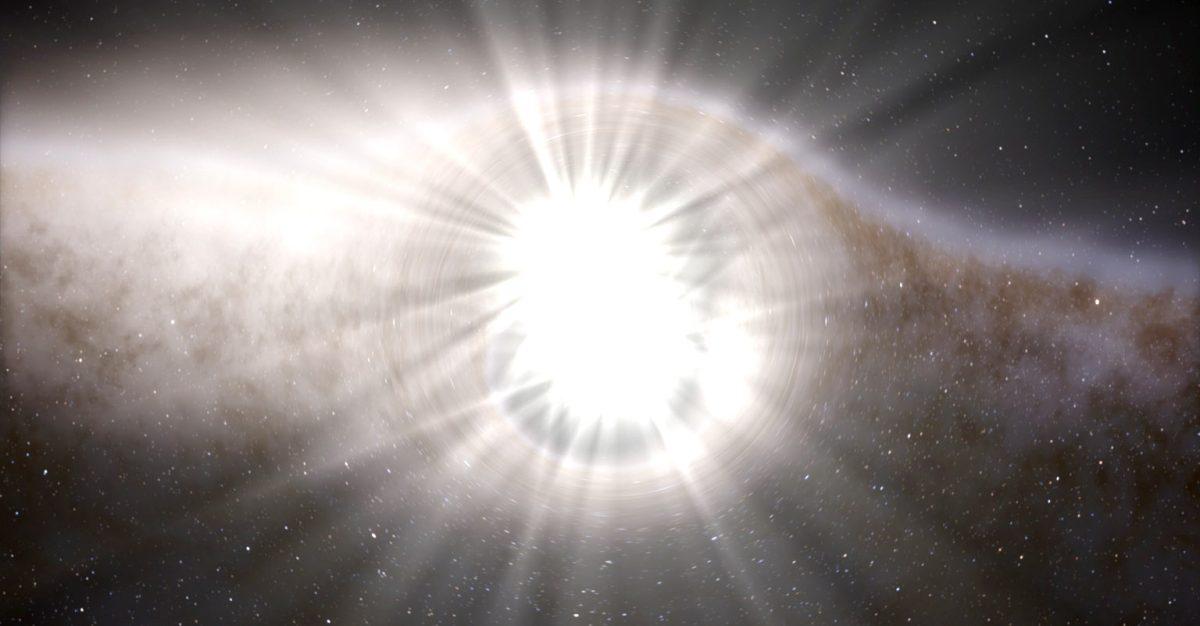“The hypothesis is that the merger of these two neutron stars is going to generate a lot of radioactive material, elements that are high in the periodic table, so things like gold, for example, or platinum,” Macri said.
According to Macri, the proof was in the light detected from the kilonova. A redder, dimmer light would indicate the presence of these elements because their electrons, dissociated from their nuclei by extreme temperatures, would block slightly more blue than red light.
“They act as sort of a curtain, or a fog, something that dims the light or acts to alter its quality,” Macri said. “You know, if you’re trying to look at the sun during a foggy day, it’s going to look dim and it’s going to look red, for example.”
According to Macri, though, the light from this kilonova was bluer and slightly brighter than expected. This meant the telescopes were viewing the event from above the plane the neutron stars had been orbiting on, since the cloud of heavy elements would be most prevalent very close to that plane.
Macri explained that a single event like this is not enough to discern exactly what was in the cloud.
“Once we have observed 20 or 30 of these events, we will have seen them from all different vantage points,” Macri said. “Each one gives us a unique slice into the conditions that are going on in that merger.”
Nicholas Suntzeff, astronomy and physics professor and member of the DES team, was part of a large team of scientists that collected and analyzed data obtained from Dome A, an Antarctic telescope outpost that, due to the four-month-long polar night, could observe the kilonova uninterrupted.
According to Suntzeff, part of the significance of the event was that it proved that light traveled at the same speed as gravitational waves; it had been hypothesized that this was the case, but since black hole mergers emit no light, this neutron star merger was the first time the hypothesis could be verified in the real world.
According to Louis Strigari, astronomy and physics professor and member of the DES team, the significance of the event was a unifying force for the astronomy community.
“This is kind of a holy grail in lots of different types of groups who were waiting for an event like this to happen because you can study it, not only through gravitational waves, but you can study it through regular light in different parts of the electromagnetic spectrum,” Strigari said.
There is, nonetheless, some disagreement about what the results of various analyses show, according to Suntzeff, especially concerning the claim that heavy elements were detected in the kilo nova.
“[The experimental results] shows that [the site of the kilonova] is a possible place for the r-process, the rapid process of nucleosynthesis, but it doesn’t by any means mean that this is how the r-process elements are produced,” Suntzeff said. “They didn’t detect gold. They didn’t detect platinum. There is no spectrum that shows that those elements exist. They detected, possibly, two elements in the spectrum, tellurium and cesium.”
According to Suntzeff, the spectra from the kilonova are close to the spectra for tellurium and cesium, but there are unexplained fluctuations in the data from the kilonova that indicate there may be more elements in the cloud.
However, these elements are less massive than the gold and platinum that the r-process is predicted to create large amounts of. According to Suntzeff, there is no real evidence yet that kilonovas are where the r-process occurs.
A neutron star merger, when two neutron stars collide due to a close orbit and gravitational radiation, is an extremely rare event. A merger that occurred on August 17, 2017 is the only such collision ever witnessed by scientists. Texas A&M astronomy and physics professor Jennifer Marshall was able to watch the merger while researching in Chile.
Marshall arrived at the Cerro Tololo Inter-American Observatory a few days prior to perform routine checks on the telescope. By doing so, she prepared it for another period of observation with the Dark Energy Survey (DES), a five-year program currently in its final year that aims to map one-eighth of the sky in extreme detail.
Several days into her stay, Marshall received an email from a colleague at the Laser Interferometer Gravitational-Wave Observatory (LIGO) there had been detection of new gravitational waves. The waves usually serve as an indication of a black hole merger, where two black holes that orbit each other very closely merge.
“When LIGO makes a detection of a gravitational wave signature, it’s not like a telescope, it doesn’t point at a region in the sky,” Marshall said. “It makes a measurement that gives you a very large ellipse on the sky where an object might be.”
With the help of Virgo, a similar detector in Italy, the LIGO team had narrowed the source down to a relatively small patch of sky, but needed a high-resolution telescope to pinpoint the exact location.
“In the email, it said that LIGO had detected a gravitational wave signal from a source that looks like it could be a binary neutron star merger,” Marshall said.
Usually, LIGO detects black hole mergers — four in its two years of operation, to be exact. According to Marshall, black hole mergers emit no light, and are thus invisible to conventional telescopes. Neutron star mergers, however, are not. They were predicted to release almost as much light as a supernova, which is an explosion of a large dying star that glows as bright as a galaxy for several weeks, Marshall said.
Marshall’s observations showed it was indeed a neutron star merger that LIGO had detected.
“From night to night, it changed a lot,” Marshall said. “Our observations matched the theoretical explanation for how these things should work, so we were pretty sure that this is what it was.”
Direct observation of a neutron star merger, according to Marshall, is an incredible opportunity to prove, or disprove, theories scientists have held about the universe.
For example, until now there ahs been no explanation for how heavy elements like gold or uranium were produced in the quantities that we see them today. According to Lucas Macri, astronomy and physics professor, neutron star mergers, also known as kilonovas, could be how these elements formed.
Texas A&M professor watches neutron star merger firsthand
October 25, 2017
Photo by Graphic by Alexandr Sein
Neutron stars, almost as dense as black holes, bend light through gravitational lensing; unlike black holes, though, they emit a significant amount of light themselves.
0
Donate to The Battalion
$1815
$5000
Contributed
Our Goal
Your donation will support the student journalists of Texas A&M University - College Station. Your contribution will allow us to purchase equipment and cover our annual website hosting costs, in addition to paying freelance staffers for their work, travel costs for coverage and more!
More to Discover










